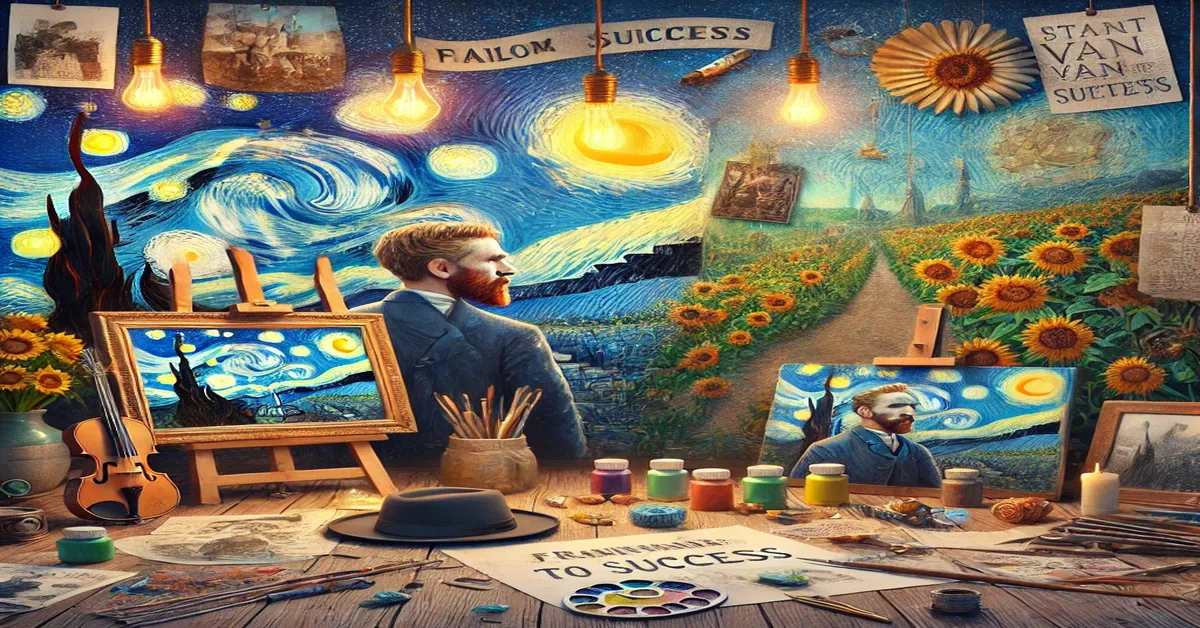Vincent van Gogh life story is a testament to how remarkable success can often emerge from what seem like endless failures. Despite his now-legendary status in the art world, van Gogh’s life was filled with moments that many would have labeled as failures. He struggled with mental health issues, financial instability, and widespread criticism of his work, all of which made his journey as an artist a turbulent one. Yet today, his name is synonymous with masterpieces and artistic genius. In this article, we explore the Vincent van Gogh Famous Failures That Were Successful, how they were pivotal to his posthumous success, and what they teach us about perseverance and the value of staying true to one’s passion.
Early Life Struggles: The First Setbacks of Vincent van Gogh
Vincent van Gogh was born in 1853 in the Netherlands, into a family with deep religious roots. Before he ever picked up a paintbrush, he encountered several life setbacks that foreshadowed the struggles he would later face. Van Gogh initially pursued careers in ministry, art dealing, and even teaching, none of which lasted. He attempted to find his calling in religious work, even working as a missionary, but found himself feeling unfulfilled. This period marked the beginning of a series of so-called “failures” that would define his early life.
Unsuccessful Career Choices
Van Gogh’s early attempts at finding a stable profession did not meet with much success. As an art dealer, his passion for the work was dampened by the commercial nature of the business, which led to his departure. His time as a missionary was no better, as he was dismissed from his position due to his unconventional approach to preaching and living among the impoverished.
Though these early ventures could be seen as failures, they played a significant role in shaping his empathetic worldview and inspiring his later works, which depicted ordinary people and scenes with a deep sense of compassion. This emotional depth became a hallmark of his paintings and ultimately contributed to their impact.
The Pursuit of Art: Vincent van Gogh’s Artistic Journey
It wasn’t until his late twenties that van Gogh decided to fully dedicate himself to art. However, even this new pursuit was riddled with obstacles. Despite pouring himself into his work, he struggled to gain recognition from both critics and fellow artists. His works were often met with confusion and rejection. Nonetheless, he painted with relentless determination, a passion that drove him despite the harsh judgments of his time.
Rejected by the Art Community
Vincent’s early works, especially those from his time in the Netherlands, were dark and somber, reflecting the lives of the working-class people he painted. One of his first major works, The Potato Eaters, was criticized for its rough, unrefined style. This rejection was painful for van Gogh, who believed deeply in the emotional authenticity of his work. However, he continued to refine his technique, learning from each setback.
Although his art was widely dismissed during his lifetime, van Gogh’s bold style later became celebrated for its honesty and raw emotion. His “failures” to fit into the accepted norms of his time ultimately contributed to his unique style, which has since been revered for its groundbreaking originality.
Struggles with Mental Health and Isolation
One of the most defining aspects of van Gogh’s life was his struggle with mental health. The emotional turmoil he experienced led to periods of isolation, hospitalization, and an intense inner conflict that is visible in many of his works. His mental health struggles were not only personal battles but also contributed to the perception that he was a “madman,” which further alienated him from society and the art world.
The Impact of Isolation on His Work
Van Gogh spent time in psychiatric hospitals and experienced long bouts of solitude. During these periods, he created some of his most iconic pieces, such as Starry Night, painted while he was in the Saint-Paul-de-Mausole asylum in Saint-Rémy. This piece, now celebrated as a masterpiece, was painted during one of the darkest times in his life, demonstrating how his struggles contributed to the intensity and depth of his art.
Though his mental health battles were undeniably painful, they added an intensity to his work that resonates with people to this day. His struggles, rather than hindering his creativity, became part of what made his art so compelling and relatable. Today, his work is appreciated for its emotional resonance, something that likely wouldn’t exist without his own painful experiences.
Financial Hardships and Reliance on His Brother
Throughout his life, van Gogh experienced constant financial instability. Unable to support himself through his art, he relied heavily on his brother Theo for financial assistance. This dependency added pressure and contributed to his feelings of inadequacy, as he desperately wanted to prove himself as a successful artist.
The Influence of Theo van Gogh
Theo van Gogh, a successful art dealer, not only provided Vincent with financial support but also offered him emotional encouragement during his darkest moments. Though Vincent saw his financial dependence as a failure, Theo’s support enabled him to continue creating art. Without Theo’s steadfast belief in his brother’s potential, van Gogh may not have produced as many of the works we cherish today.
This reliance, while a personal struggle for Vincent, ultimately allowed him to leave behind a vast collection of artwork. Theo’s support, a crucial aspect of Vincent’s journey, shows how even perceived failures can play a role in eventual success. Their relationship has become an inspiring story of sibling loyalty, reminding us of the importance of support in the face of adversity.
The Legacy of Vincent van Gogh’s Famous Failures
Despite van Gogh’s many struggles, he left an indelible mark on the art world. His works, once ignored and undervalued, are now some of the most celebrated in art history. Sunflowers, Starry Night, and The Bedroom are displayed in museums worldwide, admired for their color, movement, and emotional depth. His life, once seen as a series of tragic failures, has been re-evaluated as an inspiring story of resilience and artistic genius.
How Time Transformed Perception
During his lifetime, van Gogh sold only one painting, and his work was generally viewed as unremarkable or strange. However, after his death, perspectives began to shift. Art critics and collectors began to appreciate his unique style, vibrant colors, and emotional themes, recognizing his work as groundbreaking.
His failures became his success through the lens of time, showing us how societal standards evolve and that sometimes, true value is only recognized in hindsight. Today, van Gogh is celebrated for breaking artistic boundaries, something he was criticized for during his lifetime.
Lessons from Van Gogh’s Journey
Vincent van Gogh’s life teaches us that failure is not the end of the road. Rather, it can be a critical part of the journey to greatness. Each setback he faced, whether it was personal, financial, or professional, contributed to his growth as an artist and shaped his work in ways that made it truly unique. His resilience in the face of adversity reminds us of the importance of following our passions, even when the odds seem stacked against us.
Conclusion
Vincent van Gogh’s famous failures were more than mere obstacles; they were the catalysts that propelled him to create works that have touched millions around the world. From his struggles with mental health and financial hardship to his rejection by the art community, each challenge added depth to his life and work. His story serves as a reminder that success is not always immediate and that true worth may only be recognized with time Vincent van Gogh Famous Failures That Were Successful.
Van Gogh’s journey is a powerful example of how determination, resilience, and authenticity can turn failure into success. Today, his art is celebrated globally, a testament to the fact that greatness often emerges from hardship. Through his legacy, van Gogh inspires us to persevere and continue creating, no matter how daunting the journey may seem Vincent van Gogh Famous Failures That Were Successful.
FAQs
Why was Vincent van Gogh considered a failure during his lifetime?
During his life, he was unable to sell his work and faced criticism for his unconventional style, making him appear unsuccessful in the eyes of his contemporaries.
How did van Gogh’s mental health impact his art?
His mental health struggles added emotional depth to his art, influencing works like Starry Night, which was painted while he was in an asylum.
Did van Gogh ever achieve financial success with his art?
No, he sold only one painting in his lifetime and relied on financial support from his brother, Theo.
What was van Gogh’s relationship with his brother like?
Theo was a constant source of support, both financially and emotionally, and played a crucial role in Vincent’s life and career.
How did van Gogh’s failures contribute to his success?
His failures pushed him to refine his style and allowed him to develop a unique artistic voice that eventually earned him posthumous success.
Why are van Gogh’s works so valuable today?
His use of color, emotional intensity, and innovative techniques have made his work timeless, resonating with audiences worldwide.
What was van Gogh’s biggest struggle?
He struggled with mental health, financial instability, and a lack of recognition throughout his life.
Why is Vincent van Gogh remembered as a successful artist today?
His unique style and emotional expression have earned him lasting fame, demonstrating how his once-failed career became a lasting success through perseverance and authenticity.







